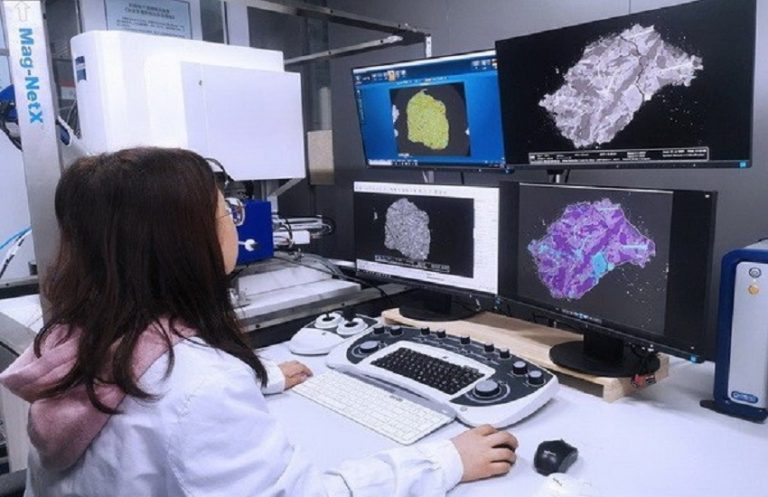
By Yu Sinan, China’s Chang’e-6 mission returned to Earth on June 25, bringing back 1,953.3 grams of lunar samples. The lunar samples, which were collected from the far side of the moon for the first time in human history, have garnered worldwide attention. They will offer fresh perspectives on the disparities between the near side and far side of the moon, as well as the evolution of the moon.
On August 21, China National Space Administration (CNSA) selected 16 research teams from 13 institutes that excelled in the research of lunar samples brought back by the Chang’e-5 mission to participate in the initial round of sample research proposal and application review for Chang’e-6 lunar samples. The Institute of Geology and Geophysics (IGG) of the Chinese Academy of Sciences (CAS) secured a spot in this selection based on its exceptional performance in the study of the Chang’e-5 lunar samples.
The Chang’e-5 probe returned to Earth on December 17, 2020, with 1,731 grams of lunar samples. The IGG received three grams of these samples and divided them into two small bottles, one holding one gram and the other holding two grams.
Li Xianhua, an academician with the CAS and a researcher with the IGG, still vividly remembers the moment when he saw the soil samples. “The moon soil was incredibly fine, with an average particle size of only 50 microns,” said Li.
“We hesitated to open the samples easily because many very fine particles not only adhered to the glass but could also escape from the bottle,” Li recalled.
After receiving the soil samples, the IGG wasted no time in calling for a project kickoff meeting. Wu Fuyuan, head of the IGG, laid out the team’s tasks clearly: conduct radiometric dating, delve into petrology and geochemistry, analyze water content, and study strontium, neodymium, and hydrogen isotopes within a week, followed by the drafting of papers for submission within another week.
The plan was not haphazardly put together. Prior to this, each member of the research team had made thorough preparations, possessing a wealth of knowledge and technological expertise.
Through relentless efforts, the team quickly achieved the first significant milestone as planned, setting a new benchmark for speed in lunar soil research. With just 0.15 grams of lunar soil, the team completed the analysis in seven days, finalized the paper in 16 days, and published three papers on Nature within 100 days, pushing back the known end time of lunar magma activity by one billion years.
“The swift progress was also attributed to the careful selection and assessment of the landing area by researchers before the Chang’e-5 mission, enabling the successful collection of the youngest lunar basalt samples. The new samples that had never been studied before allowed us to swiftly gain many new insights,” said He Huaiyu, a member of the research team and a researcher with the IGG.
Over the past three-plus years, the CNSA has shared 85.48 grams of lunar samples collected by the Chang’e-5 mission with 131 Chinese research teams in seven batches. The initial round of international applications has undergone expert evaluation. To date, more than 100 papers have been published, continuously enhancing human understanding of the moon.
International cooperation was a prominent aspect of the Chang’e-6 lunar probe mission. The mission carried four international payloads, including Pakistan’s ICUBE-Q.
It marked Pakistan’s first venture into lunar exploration. The cube satellite was jointly developed by Pakistan’s Institute of Space Technology and China’s Shanghai Jiao Tong University, with Professor Wu Shufan from the university’s School of Aeronautics and Astronautics leading the Chinese team.
“Despite its small size, ICUBE-Q boasts quite many technological innovations,” Wu said. For instance, it is equipped with on-orbit fault diagnosis algorithms that enable the satellite to automatically detect and diagnose potential system failures. The satellite also implements dynamic intelligent task scheduling strategies and utilizes advanced materials such as special magnesium alloys and honeycomb carbon fibers.
According to the mission requirements, the satellite was designed for a nominal lifespan of five hours, but in reality, it was operational in orbit for 55 days, continuously transmitting images and monitoring data, and providing valuable firsthand information for Pakistan’s lunar research.
“The achievements have far exceeded expectations,” Wu said.
China’s Chang’e-7 lunar exploration mission will carry six international scientific instruments developed by six countries and one international organization, and Chang’e-8 will offer 200 kilograms of international payload capacity and has garnered over 30 applications.
“Chang’e” belongs not only to China but also to all humanity, providing a broad stage for international space cooperation, and contributing Chinese wisdom and strength to global deep space exploration. The Chinese lunar exploration project will continue advancing without pause.










